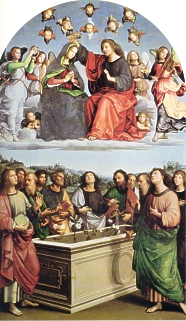
| Architecture, Mathematics and Theology in Raphael's Paintings |
|---|
Institut de Physique Théorique, Louvain- la- Neuve, and
Scuola Normale Superiore, Pisa
This subject belongs, one may say, to the prehistory of descriptive and projective geometry: it is part of our modern discovery of space. Three times a civilisation has made such an investigation: in ancient Egypt, in Antiquity, and in modern times, where perhaps we should speak of space-time. And each time, not only science, but also the arts participated in this endeavour.
This present contribution is devoted to two mathematical, that is, geometric, discoveries made in 1503 and 1504, and presented in two famous paintings by Raphael: L'incoronazione della Madonna (The Incoronation of the Madonna) and Lo Sposalizio (The Wedding of the Virgin). It is especially in the second one that we find architecture, mathematics and theology closely intertwined, in a way that is deeply characteristic for this artist, whom we can see here also as a great scientist.
 Attempts to represent
buildings in perspective go back at least to Giotto and his school.
But it seems that around 1400 Masaccio was the first to discover
the law of the vanishing point; I remind you here simply of the
Christ on the cross in Sta. Maria Novella and of his Frescoes
in Sta. Maria del Carmine. North of the Alps, the early Flemish
painters approached this law step by step, by trial and error.
This process is described in an essay by Erwin Panofsky; it seems
that the first correct painting is Dirc Bouts' Last Supper
in St. Peter's in Leuven. However, in all these paintings
we find only the use of what is sometimes called, a bit misleadingly,
"central perspective". This means that all buildings
are presented to us frontally, and the horizontal edges are either
orthogonal to our view, in the line of our view, or converging
with it. Thus, there is always only one "vanishing point",
the point towards which the parallels converge. A typical example
is the Giving of the Keys to St. Peter by Perugino in
the Sistine Chapel. Please note that this restriction forced
the painter to place all buildings parallel to each other and
frontally with respect to the observer: a severe restriction
indeed! So we may ask: who was the first painter who succeeded
in representing correctly a building in other than the frontal
position?
Attempts to represent
buildings in perspective go back at least to Giotto and his school.
But it seems that around 1400 Masaccio was the first to discover
the law of the vanishing point; I remind you here simply of the
Christ on the cross in Sta. Maria Novella and of his Frescoes
in Sta. Maria del Carmine. North of the Alps, the early Flemish
painters approached this law step by step, by trial and error.
This process is described in an essay by Erwin Panofsky; it seems
that the first correct painting is Dirc Bouts' Last Supper
in St. Peter's in Leuven. However, in all these paintings
we find only the use of what is sometimes called, a bit misleadingly,
"central perspective". This means that all buildings
are presented to us frontally, and the horizontal edges are either
orthogonal to our view, in the line of our view, or converging
with it. Thus, there is always only one "vanishing point",
the point towards which the parallels converge. A typical example
is the Giving of the Keys to St. Peter by Perugino in
the Sistine Chapel. Please note that this restriction forced
the painter to place all buildings parallel to each other and
frontally with respect to the observer: a severe restriction
indeed! So we may ask: who was the first painter who succeeded
in representing correctly a building in other than the frontal
position?
Perugino's fresco dates from 1480-81. But in 1503 his pupil, Raphael, was invited to paint for the church of the Franciscans in Perugia an Incoronation of the Madonna, which is today in the Pinacoteca del Vaticano. I think that this is the first painting where a structure in a non-frontal position, the sarcophagus of the Madonna, is constructed rigorously. At least I have never seen an earlier one myself. So the question arises: how did Raphael do it? How did he achieve what so many others, presumably, had tried to do in vain?
ILLUSTRATION: Raphael's Incoronation of the Madonna, 1503, now in the Pinacoteca del Vaticano, Rome.
ABOUT
THE AUTHOR
David
Speiser
is Professor Emeritus at the Catholic University of Louvain,
where he taught physics and mathematics from 1963 to 1990. His
research concerned elementary particles and physical mathematics.
He has been giving lectures and seminars regularly at the Scuola
Normale di Pisa since 1990. Since 1980, he is the general editor
of the complete works of the mathematicians and physicists of
the Bernoulli family. His work on the history of science includes
various publications, some of which are related to art history.
He presented "The
Symmetries of the Leaning Tower and the Baptistery of Pisa"
at Nexus '96, now available in Nexus:
Architecture and Mathematics (1996).
|
David Speiser, "Architecture, Mathematics and Theology in Raphael's Paintings", pp. 147-156 in Nexus III: Architecture and Mathematics, ed. Kim Williams, Pisa: Pacini Editore, 2000. http://www.nexusjournal.com/conferences/N2000-Speiser.html |
|
|
|
|
